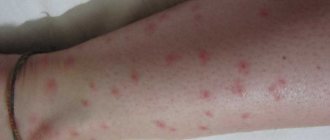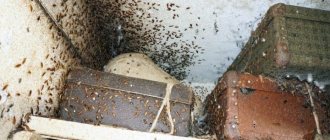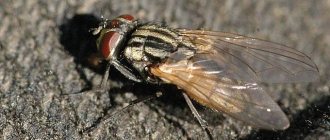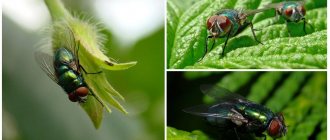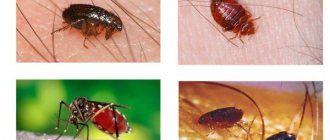08.04.2020
In summer, insects are literally everywhere. Some species are pleasing to the eye or beneficial, while others, on the contrary, cause a lot of trouble. But with the arrival of autumn everything changes. Insects do not accumulate fat, like marmots or bears, so nature has developed special methods to wait out frosts. Some species fly to warmer climes, some die, leaving behind offspring, and some try to survive in unfavorable conditions. Let's look at common wintering options for insects.
- Bees
- Ants
- Mosquitoes and flies
- Butterflies
- Wasps
- Other pests
Bees
The process of preparing for wintering for wild bees is very complex. With the onset of the first cold weather, the queen stops laying eggs. The closer it gets to winter, the less often bees fly out of the hive. Working individuals from the street bring cold air into the hive, thereby disturbing the temperature regime, and young animals, unlike adults, do not tolerate low temperatures well; cold air is destructive for them. Inside the hive, insects form a ball or ball in which they wait out the cold. Although the bees inside the ball hardly move, life in it does not stop. The top individuals of the ball are located close to the honeycombs with honey, but the bees inside also need to eat, so when they get hungry, they move upward, closer to the food. Individuals that freeze, on the contrary, make their way inside, where it is warmer, or climb into honeycombs, where they warm up. Of course, it is not possible without losing fighters in the cold, but this method helps most of the bee colony survive until spring.
Bee
Beekeepers take care of domestic bees. But the principle of wintering wild and domestic bees is similar. Many bee lovers make the mistake of over-insulating the hive. In this case, a person draws an analogy with domestic animals, which are transferred from open pastures to insulated sheds for the winter. But if in the case of livestock this is a necessity, then for bees such measures are unnecessary. As we know, in winter insects feed on honey, while they release moisture. Increased humidity inside the hive is created, the honeycombs become moldy, and the bees suffer from heat and dampness. By the end of winter, many families die. Bees often live better in hives with slits or a pushed-off lid than in well-prepared, insulated hives.
Wild bees
With the wintering of domestic bees, everything is clear - the necessary conditions are created for them by the beekeeper. For wild brothers, everything is much more complicated. With the onset of cold weather, they independently go through a multi-stage process:
- The uterus slows down and then stops egg laying altogether.
- Insects stop flying out of the nest. Adults are not afraid of the autumn cold, but young animals need constant warmth. A bee arriving from outside could disrupt the temperature regime.
- With the onset of the first frost, insects gather in a lump or club and almost stop moving. It is typical that the accumulation is placed on empty combs, and only its upper part can touch the honeycombs.
- The bees spend the entire winter in the club. During this period they act as a single unit. Those of them who feel cold move to the center, and those who are hungry move up to the honeycomb. If a bee gets cold, it moves into empty honeycombs, using them as a blanket.
Preparation for winter begins with the first cold snap (usually in September) and ends with the onset of November frosts. At this point, the insects are already in the club.
Ants
Overwintering of ants depends on the species - some species hibernate, and some do not stop working all winter. We will tell you more about the latter.
Ants
Long before the cold weather arrives, the queen ant stops laying eggs. Working individuals stock up on food for the winter - plants, berries, fruits, seeds. They store it in specially dug compartments. At the same time, other individuals make deeper passages in the anthill. Insects seal the entrances and exits from the anthill with pebbles, sawdust, pine needles, and earth so that cold air does not get inside. The entire ant family moves deeper into its home. Due to the fact that the ground at such a depth does not freeze, the temperature in the entrances remains high, which allows the ants to wait out the winter.
Scientists' alarm
Over the past few decades, experts have come to the conclusion that a huge number of butterflies are leaving their natural habitat. They fly to big cities. This is due to the fact that urban objects emit heat, which attracts lepidoptera. They settle in basements, on the roofs of houses and factories. Due to the fact that the butterfly does not fall into suspended animation, it soon dies. These facts worry scientists more and more.
Butterflies bring enormous benefits to the flora world. They are in second place in plant pollination after bees! Did you know that a butterfly only tastes food when it stands on it?! The thing is that the taste buds of lepidopterans are on their paws!
Our article has come to an end. You learned where butterflies and mosquitoes hide for the winter, as well as what happens to insects during the cold season.
The time has come when mothers take our warm sweaters and gloves out of the closet, because summer is over and autumn will soon pass, and a snow-white guest will come to us - winter. The bear is looking for a den in which to sleep until spring, the birds are flying to warmer climes, and how do insects prepare for winter?
Let's remember what insects we know
- Red wings, black peas. Who is this walking on my palm? Ladybug .
- The next miracle bug is the biggest hard worker of all, sometimes it bites and an ant .
- Early in the morning she cannot sleep - she really wants to work. So the hard-working woman brought honey. bee _
- Your ear knows how I buzz on a summer day. I fly into every house, they call me. front sight
- He lives in a dark corner, weaves a silk thread, he secretly climbed here, planning to build a new house. It's a spider . It is often mistakenly considered an insect, but it belongs to a number of arthropods from the class Arachnida.
How insects prepare for winter
Remembering the types of insects, we learned that they all have their own characteristics, and, therefore, prepare for winter in different ways. Let's find out how. How does a ladybug prepare for winter? Everyone loves this little beauty because it has a bright glossy color and is considered a symbol of happiness. However, the bugs are not very friendly with each other; they are apparently dreamers who enjoy life alone. But when the leaves begin to fall outside and the air becomes cool, ladybugs unite in groups and look for warm places for wintering, such as tree bark, moss, stones. Smart red and black beads hide in apartments. The main task of the sun in autumn is to find a dry and cozy place to relax. Unfortunately, these insects do not see a snowy winter, because they hibernate before it arrives.
How does an ant meet winter? Ants constantly stay in groups and throughout their lives they build houses called anthills. These hardworking insects are not at all afraid of the cold, because they do not freeze even when we put on fur coats and gloves. They do not need to look for a place to spend the night in the winter, because they can always rest in the labyrinths of the anthill. However, they are still preparing for winter. So, in the fall, a special liquid is released in the ant’s body, which warms it from the inside. And it's called glycerin. It is thanks to this magical liquid that ants do not freeze in winter.
How do bees winter? Working bees do not hibernate during the winter. With the onset of cold weather, the queen stops laying eggs, and the bees spend more and more time in the nest. All of them accumulate around the larvae and pupae to maintain the temperature necessary for their life. Bees do not perform any work in winter; they sit almost motionless. A ball of bees consists of 30-35 thousand individuals. The temperature inside the ball is always higher than outside. Therefore, the bees that are frozen squeeze deeper, and their place is taken by the bees that have been warm. The main enemies of bees in winter are strong winds, humidity and hunger, so beekeepers should try to provide the bees with a calm and comfortable winter.
And the spider is a coward. In autumn, spiders hide to avoid facing the cold winter. The water spider wraps itself in a cocoon and dives underwater, where it falls asleep until spring. Spiders that live in the forest or on the street hide in wooden bark. And those that scare us at home fall asleep somewhere in the cracks.
What do mosquitoes and flies do in winter? Interestingly, mosquitoes and flies hide in window frames and cracks of houses during the winter. A fly that has fallen into hibernation can survive for six months or more. With the onset of warmth, the flies come to life and walk around as if sleepy. Having come to their senses, the insects return to their normal life, which usually lasts about a month. And mosquitoes often do not survive until winter. Adults spend their entire lives, namely summer and autumn, on land. Then all the male mosquitoes die, and the females (and not all of them) go to reservoirs to wait out the winter and lay eggs in the spring to give birth to a new life.
Now we know where insects hide in winter: they find comfortable places in which they sleep soundly. And at this time we play snowballs, sculpt a snow woman, celebrate the Nativity of Christ and the New Year and very rarely meet sleepy insects.
When cold weather sets in, many animals go into survival mode. We humans have been able to remake the environment quite well for ourselves. We settle into houses, turn on the heating and eat fresh food bought in stores.
Animals have completely different living conditions. Both food and shelter are difficult to find in winter, so they have to use different survival tactics. Some mammals hibernate. Birds sometimes fly south in winter. But where do the little crawling creatures go? Where do insects spend the winter?
Mosquitoes and flies
With the onset of autumn, annoying insects look for a secluded warm place. Most often, they move closer to a person’s home, hiding in cracks and joints on the floor and walls, in wooden window frames, in basements and sheds. In winter they fall into a state of diapause, and in the spring they wake up and continue their life activities. Sometimes, when the temperature outside the window rises in the fall, you can see sleepy flies or lethargic mosquitoes in the house.
Fly
It is noteworthy that only female mosquitoes, eggs and larvae remain to wait out the cold; the males die at the end of summer.
Mosquito
Mosquitoes in autumn
It is known that as soon as the summer heat gives way to the September cold snap, the number of mosquitoes on the street decreases sharply. As is known, a huge part of these insects die after laying the first eggs. Those mosquitoes that survive are looking for comfortable places where they can easily spend the winter. These blood-sucking insects in autumn and winter can be found in the bark of dry trees and hollows, in grass, moss, burrows, various deep caves, and so on. They tolerate winter cold without any difficulties at any stage of development, no matter whether it is an adult, larva or pupa. Mosquitoes in the basement or cellar will quietly overwinter, and as soon as warm summer days arrive, they will leave the shelter and go hunting.
Butterflies
Some species of butterflies fly to warmer climes in the fall. The most famous species of migratory butterfly is the monarch. They are able to travel thousands of kilometers; air currents help them in this. This type of butterfly lives in North America, but Russia also has its own traveler butterflies, for example the burdock. The first generation of butterflies arrives in the middle zone in late May - mid-June, the second generation - in mid-July - early October. And this second generation will most likely fly back to the south for the winter.
Butterfly hives
Some butterflies, such as the urticaria, remain to wait out the cold in the middle zone. To survive in frosts, butterflies hide under the bark of trees, under fallen leaves, in brushwood, where conditions acceptable for life are created.
But most butterflies, due to their short lifespan, do not live until autumn, but leave behind offspring in the form of eggs and caterpillars. The eggs are stored until spring, and in the spring the caterpillars hatch. And the caterpillars pupate, which allows them to survive in this form until spring.
When do mosquitoes appear?
When blood-sucking mosquitoes appear depends largely on climate and external factors. Facts have been recorded when larvae from eggs and midges appeared in the spring. After all, it was in May that the water warmed up enough. The larval pupa appeared within 2–4 days. It took another 6–10 days for an adult to form. The duration of the breeding cycle varies from 14 to 60 days. And it largely depends on the temperature level. At temperatures of 20–25 degrees, adult mosquitoes can live for about 30–45 days. It all depends on gender and conditions. For a full-fledged existence, insects require not only acceptable temperature and humidity, but also food.
Not all species of mosquitoes that have appeared on earth consume blood. Some varieties prefer plant sap or flower nectar. But in most cases, females need protein, which is present in human blood. Protein promotes rapid fertilization and bearing healthy offspring. Therefore, as soon as mosquitoes appear, it is necessary to stock up on all kinds of drugs, protective devices and universal means. After all, these insects often cause some harm to humans.
Wasps
Most wasps and hornets die by autumn. Only young females remain alive and are capable of reproducing offspring. They, like many insects, overwinter under the bark and in cracks of trees, in a pile of fallen leaves or withered grass, and use rotten stumps or trunks of fallen trees for overwintering. During this period, vital processes practically cease, and insects become insensitive to low temperatures. The wasp body produces a substance similar in properties to antifreeze. It prevents the fluids in the wasp's body from crystallizing.
Wasp
With strong fluctuations in outdoor temperatures, the chemical composition of the cells in the wasp’s body changes, which is why the substance “antifreeze” ceases to be produced. When the temperature drops, the liquids crystallize, which leads to the death of the wasp queen.
Other pests
In addition to the types of insects listed above, there are a large number of insect pests, which in most cases wait out the winter on the plots. Some types of pests, such as caterpillars, crawl under the bark of trees, under fallen leaves, into unharvested grass and dead bushes. Caterpillars, as a rule, turn into pupa and spend the winter in this form. Other garden pests, such as aphids or spider mites, lay eggs during the winter, and with the arrival of spring, young and voracious insects hatch. Other types of pests, such as spider mites, simply go deeper into the ground, where conditions favorable for their survival remain, and wait out the winter in diapause. During this period, all processes in the insect’s body slow down. They do not move, do not consume food, and hardly breathe. The substances accumulated in the intestines over the summer are enough to maintain life in the insect’s body until spring. When the air temperature rises to 12-14 degrees Celsius, insects come to the surface and actively continue their life activities.
Where do all the insects go in the fall? It seems obvious, but if you look deeper, it’s interesting
Summer is over, and with it the warm days. The days when a mosquito rang unbearably in your ear all night. The days when shameless flies brightened up your loneliness with their annoying presence. The days when a horde of midges rushed towards you in a swarm, you just had to step over the threshold in the evening. Of course, we won’t miss the annoying creatures. But the question remains open: where do the bugs actually go for the winter, and why does this happen?
For most invertebrates, winter = death
.
Beeches are cold-blooded
, that is, their life activity directly
depends on the temperature in the area
. The first serious frosts send most of the arthropods to their forefathers, so they have to resort to various tricks to survive.
For example, spiders
, feeling that winter is coming,
they wrap the kids in a thick cocoon of poutine
somewhere
in your attic
.
Having wrapped their offspring in diapers, the animals throw back their paws
with a sense of accomplishment.
Adults are not able to survive the cold
, but their children spend the winter in quite comfortable conditions, coming out into the light with the arrival of warmth.
But not everyone wants to sacrifice themselves for future generations. Many types of beetles and butterflies
love and lay eggs
long before the onset of cold weather
- in
May - June
.
Until autumn, the larvae quietly gain fat, and the parents get high, enjoying the summer days. And when the beater comes, the kids burrow deep underground
, waiting out the severe frosts in cocoons.
But what should social insects do? Shouldn't the whole swarm die when you built a damn empire over the summer? In ants, bees and termites
The principle “
warmth, but not offensive
” works.
Pressing each other as closely as possible, they bask in the warmth of their bodies
.
And some didn’t even care about the cold. Mosquitoes, flies and midges
They overwinter where they are frozen:
eggs - in water
,
carrion and excrement
,
pupae - in the ground
,
adults clog all sorts of holes
(including in your home!), plunging into
diapause
.
Diapause is a state when all life processes are reduced to a minimum
, thanks to which the puny insect body
tolerates extremely low temperatures
.
A kind of hibernation for arthropods. It is clear that not everyone will survive the cold, but those who succeed will fall into a half-dead state until the warmth arrives
.
But where do the winterers hide? Yes everywhere. Generally everywhere
.
Any stone, leaf, crevice, debris or just loose earth is a shelter
. Try this experiment for fun in the winter: dig up a piece of soil somewhere in a field, put it in a three-liter jar and warm it up. We answer, in a couple of days so much cool stuff will come out of this mud that you will simply go nuts!
Source:Go
Read us on Odnoklassniki VKontakte Telegram



